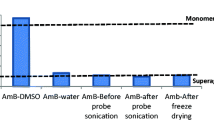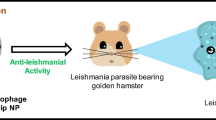Abstract
Purpose
Amphotericin B (AMB), an effective antifungal and antileishmanial agent associated with low oral bioavailability (0.3%) and severe nephrotoxicity, was entrapped into poly(lactide-co-glycolide) (PLGA) nanoparticles to improve the oral bioavailability and to minimize the adverse effects associated with it.
Materials and Methods
The AMB-nanoparticles (AMB-NP) were prepared by nanoprecipitation method employing Vitamin E-TPGS as a stabilizer. In vitro release was carried out using membrane dialysis method. The in vitro hemolytic activity of AMB-NP was evaluated by incubation with red blood cells (RBCs). The acute nephrotoxicity profile and oral bioavailability of AMB-NP were evaluated in rats.
Results
The prepared AMB-NP formulation contained monodispersed particles in the size range of 165.6 ± 2.9 nm with 34.5 ± 2.1% entrapment at 10% w/w initial drug loading. AMB-NP formulation showed biphasic drug release, an initial rapid release followed by a sustained release. The AMB-NP formulation exerted lower hemolysis and nephrotoxicity as compared to Fungizone®. The relative oral bioavailability of the AMB-NP was found to be ∼800% as compared to Fungizone®.
Conclusion
Together, these results offer a possibility of treating systemic fungal infection and leishmaniasis with oral AMB-NP, which could revolutionize the infectious disease treatment modalities.






Similar content being viewed by others
References
C. Junhass, and K. A. Marr. Infectious risks and outcomes after stem cell transplantation: are nonmyeloablative transplants changing the picture? Curr. Opin. Infect. Dis. 15:347–353 (2002).
D. P. Kontoyiannis, and G. P. Bodey. Invasive aspergillosis in 2002: an update. Eur. J. Clin. Microbiol. Infect. Dis. 21:162–172 (2002) doi:10.1007/s10096-002-0699-z.
R. D. Meyer. Current role of therapy with amphotericin B. Clin. Infect. Dis. 14:S154–S160 (1992).
C. Gates, and R. J. Pinney. Amphotericin B and its delivery by liposomal and lipid formulations. J. Clin. Pharm. Ther. 18:147–153 (1993) doi:10.1111/j.1365-2710.1993.tb00605.x.
C. P. Thakur, A. K. Pandey, G. P. Sinha, S. Roy, K. Behbehani, and P. Oilliaro. Comparison of three treatment regimens with liposomal amphotericin B (Ambisome) for visceral leishmaniasis in India: a randomized dose finding study. Trans. R. Soc. Trop. Med. Hyg. 90:319–322 (1996) doi:10.1016/S0035-9203(96)90271-0.
S. Sundar, and M. Rai. Advances in the treatment of leishmaniasis. Curr. Opin. Infect. Dis. 15:593–598 (2002).
S. Arikan, and J. H. Rex. Lipid-based antifungal agents: current status. Curr. Pharm. Des. 5:93–415 (2001).
H. A. Gallis, R. H. Drew, and W. W. Pickard. Amphotericin B: 30 years of clinical experience. Rev. Infect. Dis. 12:308–329 (1990).
R. H. Müller, and K. Peters. Nanosuspensions for the formulation of poorly soluble drugs. I. Preparation by a size-reduction technique. Int. J. Pharm. 160:229–237 (1998) doi:10.1016/S0378-5173(97)00311-6.
O. Kayser, C. Olbrich, V. Yardley, A. F. Kiderlen, and S. L. Croft. Formulation of amphotericin B as nanosuspension for oral administration. Int. J. Pharm. 254:73–75 (2003) doi:10.1016/S0378-5173(02)00686-5.
V. Risovic, M. Boyd, E. Choo, and K. M. Wasan. Effects of lipid-based oral formulations on plasma and tissue amphotericin B concentrations and renal toxicity in male rats. Antimicrob. Agents Chemother. 47:3339–3342 (2003) doi:10.1128/AAC.47.10.3339-3342.2003.
R. Santangelo, P. Paderu, G. Delmas, Z. W. Chen, R. Mannino, L. Zarif, and D. S. Perlin. Efficacy of oral cochleate-amphotericin B in a mouse model of systemic candidiasis. Antimicrob. Agents Chemother. 44:2356–2360 (2000) doi:10.1128/AAC.44.9.2356-2360.2000.
A. K. Meena, D. Venkat Ratnam, G. Chandraiah, D. D. Ankola, P. Rama Rao, and M. N. V. Ravi Kumar. Oral nanoparticulate atorvastatin calcium is more efficient and safe in comparison to Lipicure® in treating hyperlipidemia. Lipids. 43:231–241 (2008) doi:10.1007/s11745-007-3142-5.
S. McClean, E. Prosser, E. Meehan, D. O’Malley, N. Clarke, Z. Ramtoola, and D. Brayden. Binding and uptake of biodegradable poly-DL-lactide micro- and nanoparticles in intestinal epithelia. Eur. J. Pharm. Sci. 6:153–163 (1998) doi:10.1016/S0928-0987(97)10007-0.
G. Mittal, D. K. Sahana, V. Bhardawaj, and M. N. V. R. Kumar. Estradiol loaded PLGA nanoparticles for oral administration: effect of polymer molecular weight and copolymer composition on release behavior in vitro and in vivo. J. Control Release. 119:77–83 (2007) doi:10.1016/j.jconrel.2007.01.016.
U. Bilati, E. Allemann, and E. Doelker. Development of a nonoprecipitation method intended for entrapment of hydrophilic drugs into nanoparticles. Eur. J. Pharm. Sci. 24:68–69 (2005) doi:10.1016/j.ejps.2004.09.011.
K. Dillen, J. Vanderwoot, G. V. D. Mooter, and A. Ludwig. Evaluation of ciprofloxacin loaded Eudragit® RS100 or RL100/PLGA nanoparticles. Int. J. Pharm. 314:72–82 (2006) doi:10.1016/j.ijpharm.2006.01.041.
D. K. Sahana, G. Mittal, V. Bhardwaj, and M. N. V. Ravi Kumar. PLGA nanoparticles for oral delivery of hydrophobic drugs: Influence of organic solvent on nanoparticle formation and release behavior in vitro and in vivo using estradiol as a model drug. J. Pharm. Sci. 97:1530–1542 (2008) doi:10.1002/jps.21158.
S. R. Jameela, N. Suma, and A. Jayakrishna. Protein release from poly (ε-caprolactone) microspheres prepared by melt encapsulation and solvent evaporation techniques: a comparative study. J. Biomater. Sci. Polym. Ed. 8:457–466 (1997) doi:10.1163/156856297X00380.
C. Paulo, and M. S. L. Jose. Modeling and comparison of dissolution profiles. Eur. J. Pharm. Sci. 13:125 (2000).
S. Hariharan, V. Bhardwaj, I. Bala, J. Sitterberg, U. Bakowsky, and M. N. V. Ravi Kumar. Design of estradiol loaded PLGA nanoparticulate formulations: a potential oral delivery system for hormone therapy. Pharm. Res. 23:184–195 (2006) doi:10.1007/s11095-005-8418-y.
J. L. Italia, D. K. Bhatt, V. Bhardwaj, K. Tikoo, and M. N. V. Ravi Kumar. PLGA nanoparticles for oral delivery of cyclosporine: Nephrotoxicity and pharmacokinetic studies in comparison to Sandimmune Neoral. J. Control Release. 119:197–206 (2007) doi:10.1016/j.jconrel.2007.02.004.
A. W. Ritschel, and G. L. Kearns, Pharmacokinetic parameters of important drugs. Handbook of Basic Pharmacokinetic. American Pharmaceutical Association, Washington, p 484 (1998)
Acknowledgement
Authors acknowledge financial support from Department of Science and Technology (DST), Government of India. M. M. Yahya is grateful to NIPER for providing MS fellowship. Dr. V. Beniwal is acknowledged for AFM imaging.
Author information
Authors and Affiliations
Corresponding author
Rights and permissions
About this article
Cite this article
Italia, J.L., Yahya, M.M., Singh, D. et al. Biodegradable Nanoparticles Improve Oral Bioavailability of Amphotericin B and Show Reduced Nephrotoxicity Compared to Intravenous Fungizone®. Pharm Res 26, 1324–1331 (2009). https://doi.org/10.1007/s11095-009-9841-2
Received:
Accepted:
Published:
Issue Date:
DOI: https://doi.org/10.1007/s11095-009-9841-2




